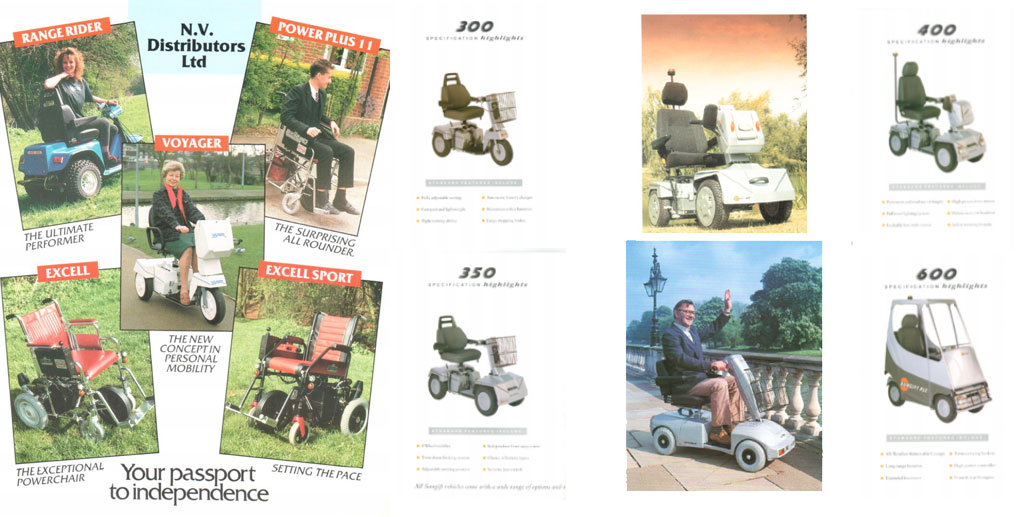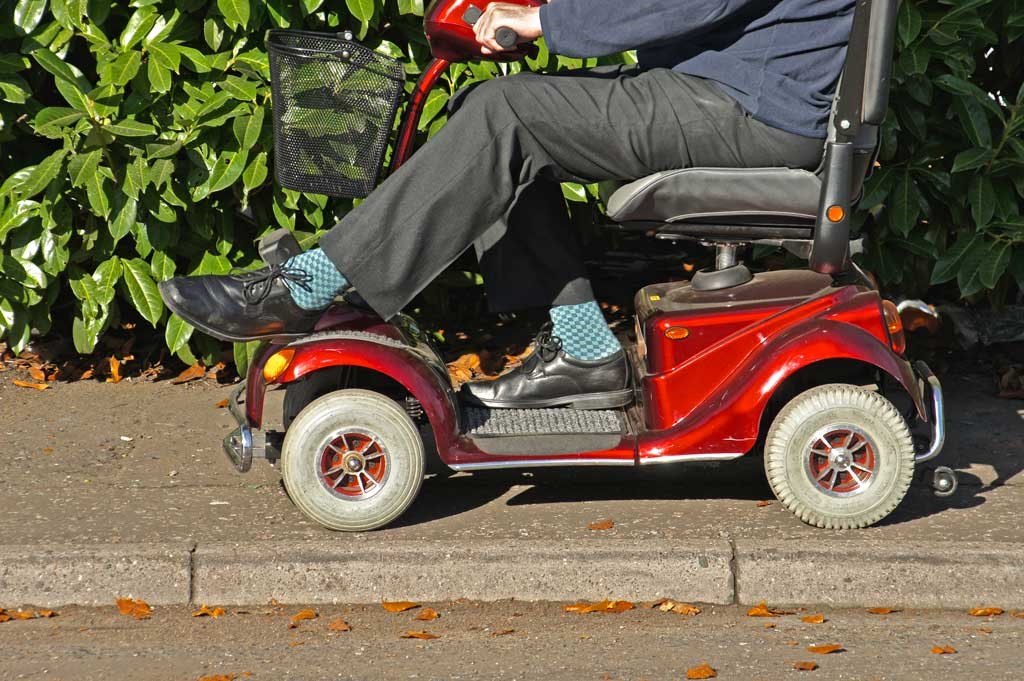Electric Mobility Scooters – Our Story
How AVC came to develop the Quingo mobility scooter
Electric Mobility Scooters – An Unofficial History
In the world of electric mobility scooters Quingo is synonymous with quality, comfort and safety. However, it is a little-known fact that the family behind all this innovation has been at the forefront of personal mobility for three generations.
A Brief Timeline of Personal Mobility
Electric invalid carriages made their first appearance in England in the 20s but, what we would call modern electric mobility scooters, are a fairly recent development that the Nicholls family have been at the very heart of.
After World War II, in the UK, wheelchair users, and veterans who had suffered significant injuries, could be offered an invalid carriage subsidised by the government.
These invalid carriages were almost all petrol powered and the most popular models were the Invacar and AC Model 57, though, there were a number of other small manufacturers.
Most of you will remember them as the small, pastel blue three wheeled “cars” that slowly disappeared from our roads in the 70s and 80s.
The few remaining in government ownership were withdrawn and scrapped in 2003 due to safety concerns. Not really surprising if you consider they had a claimed top speed of over 80 miles per hour, had only three wheels (more of which later) and weighed next to nothing! We think the maximum top speed for electric mobility scooters of 8mph for class 3 scooters, and 4mph for class 2, is much more sensible!
There were a very small number of electric powered invalid carriages that were introduced specifically for those with more profound disabilities. The reason behind using battery power was the facility to considerably simplify controls, removing the need for gear levers and clutches while avoiding the high costs incurred by using column shits and automatic gearboxes. These represent the last iteration of the invalid carriage genre and will ultimately lead us to the emergence of modern electric mobility scooters.

These images are used under the Attribution-Share Alike 3.0 Unported
Electric Mobility Scooters – The American Connection
While the invention of the modern electric mobility scooters is often attributed to Allan R. Thieme of Michigan in 1968, the basic design he came up with for his wife is still in use (or at least similar designs) in supermarkets as loan vehicles to do your shopping. However, these were very primitive and didn’t really gain mass acceptance.
However, the reality is that, the first recognisable electric mobility scooters were introduced by Sears in the early 50s but, they were not a success, and were soon withdrawn from sale.
The Family History Behind the Quingo Brand of Electric Mobility Scooters
In 1957 the family behind the Quingo range of 5-wheel electric mobility scooters became involved in the mobility world, supplying and servicing mobility vehicles, with R F Nicholls Ltd becoming a Ministry of Health Approved Repairer.
In the early 60s Graham Nicholls joined the company and his introduction to the world of personal mobility was, being presented with a Tippin Delta, given a tool kit and told to carry out the full Ministry of Health refurbishment required when a vehicle was about to change be assigned to a new “owner”. With ministry guidebook to hand the Tippin was swiftly stripped and rebuilt and, it was at this point, Graham realised he may have a mechanical bent and the engineer in him awoke.
This company remained successful and was steadily expanded and improved offering ever better service.
In the mid 70s the foundation for a nationwide distribution network was established and, in 1979 the family, with a desire to improve on available solutions, started to develop their own personal mobility vehicles.
So, we entered the 80s and in 1981 Graham Nicholls launched the family’s first Powerchair. The Power Plus Chair introduced a ground-breaking way of transferring the drive from the electric motor via a gear direct to teeth on the inside of the drive wheel.
This innovation significantly boosted the torque available from the more primitive, lower powered electric motors available at the time, making for far greater traction and usable power. With the Power Plus Chair you really were going places!

Graham soon set his mind to solving the issue presented by climbing kerbs, the dropped kerb being some way off being widely introduced, in a wheelchair and the Kerb Roller was introduced in 1981 as an accessory for the Power Plus Chair.
There was a competitive contraption at the time, that used the momentum of your chair to activate two legs to lift the front of the chair.
In order to “safely” use this you had to find an even kerb, line up exactly perpendicular to the kerb, and then proceed at a fairly precise speed to the kerb where, the force of hitting the kerb, would bring the device in to action; once you were committed to this you could not change your mind or you would either hit the kerb with a potentially unpleasant jolt or end up stuck on the legs on the edge of the kerb with no way off. This device sounds frankly terrifying!
Not satisfied with his innovations Graham was already working on a design for a truly transportable outdoor electric mobility scooter and in 1983 the Voyager was launched.
With the success of these products it was time to look at new ways to make owning, insuring and maintaining a scooter much cheaper and easier and 1985 saw the launch of the first national, insurance backed service plan.
In 1988 Mark Nicholls, the son of Graham, qualified from university and joined the family firm.
With father and son working in tandem, the following years saw a flurry of innovation and improved designs. This was to continue in to the 90s where the first transportable 4-wheel electric mobility scooters were introduced by Graham and Mark and which culminated in 1993 with the launch of the first transportable mini scooter, the 200.

In 1996 having piloted the company to become one of Europe’s largest scooter manufacturers, the desire for further innovation and excellence, shared by both father and son, prompted the sale of this enterprise in order to invest in a truly different approach to providing electric mobility scooters and powered wheelchairs.
AMC and Forever Active
In 1997 AMC was incorporated and a completely new range of devices once again moved the world of personal mobility ever forward.
In 2001 Forever Active was formed to handle the distribution and aftercare of these devices in the UK, and continues to this day to offer a service you will find hard to beat.
However, Graham’s and son Mark’s desire to come up with truly unique designs and solutions was still burning strong and the concept of the five-wheel Quingo was about to become a reality.
Quingo the 5-Wheel Future
The father and son team were acutely aware of the benefits and downfalls of both 3 and 4-wheel designs and decided they wanted to make the best scooter they could imagine and the Quingo was conceived.

AVC was formed in 2004 to develop the Quingo brand and our revolutionary 5-wheel technology that would become known as Quintell™ Technologies.
Graham set about leveraging the knowledge and expertise he had gained from having been in the mobility scooter business for so many years making both three and four-wheel scooters, and the fresh ideas coming from the younger mind of his son Mark complimented and furthered this undertaking.
A Problem is Only a Problem Until you Find a Solution
AVC and the Quintell™ technical team were once again about to combat the bane of many mobility devices, that of kerbs.
Though dropped kerbs were by now commonplace, the ever increasing number vehicles on the road led to inconsiderate parking becoming commonplace, with dropped kerbs often being rendered impassable and pavements blocked.
This increasingly makes it necessary to mount or disembark from the pavement where there is no available dropped curb.
One again the users of personal mobility devices would have to find a suitable place to climb a kerb, however dismounting could be very dicey as pavements are often narrow meaning it is often impossible to approach the kerb at a right angle.
The brief was that you would no longer be reliant on dropped kerbs, regular kerbs should no longer present a challenge but instead should be something the scooter is designed to handle with ease and in complete safety.
While both three and four wheeled designs could mount kerbs, this often led to instability, even when the kerb was approached head on. This instability can sometimes cause the tiller to jerk violently leading to strain related damage to the driver or, much worse, it could result in loss of control of the scooter leading to potentially serious personal injury.

The worst affected by instability were the three-wheel variety where the design is extremely susceptible to tipping when kerbs are negotiated at anything other than a right angle.
While four-wheel scooters do indeed give far greater stability in comparison to three wheels there is a compromise that has to be made.
By utilising four wheels, the tight turning circle that is the biggest advantage of the three wheel scooter, is severely impacted, growing significantly.
The need to house an axle detracts from the space available for the driver’s feet and legs, leading in turn to poor posture and discomfort, not a desirable trait where the pain associated with many conditions can be greatly exacerbated by this poor posture.
The picture below shows two possible ways to place your feet on a four-wheel scooter. Both of these are far from ideal.

So, a radical new approach to the steering system was needed and our Active Tri-Wheel Steering system was designed and perfected.
This ingenious design allows our scooters to mount and dismount kerbs at up to a 45 degree angle, safely.
Active Tri-Wheel Steering offers turning performance on a par with 3-wheel scooters, but with none of the inherent restrictions as, it can also easily match and, certainly in handling kerbs and rough surfaces, surpass the characteristics of the 4-wheel scooter.
Our Active Tri-Wheel Steering gives an additional benefit of granting up to 80% more room for your legs and feet when compared to a similar 4-wheel scooter and this, combined with our Feet Forward Adaptive Floating Footplates, fully adjustable seats and tillers make the Quintell™ Posture Control System responsive to your body and ergonomically correct.
Another Quintell™ first can be found in the self-driving, fully automatic KerbMaster™ anti-tip and anti-beach system.
In 2005 the Quintell™ Technology patent was applied for and in 2007 the first models of our electric mobility scooters to feature the benefits the Classic and the Plus were launched.
In independent testing the 5 wheel design, and the innovations behind them, were conclusively proven to offer myriad benefits.
The range continued to expand, offering greater functionality and adaptability to lifestyle requirements, such as the introduction of the Air car boot scooter.
In 2009 AVC began its Global Distributor Programme and presently you can buy a Quingo in Australia, France, Holland, India and the USA.
Between 2010 and 2012 AVC was granted worldwide patents for the innovations that make for the Quingo Advantage.
In 2014 AVC introduced the self-loading Flyte to the world. As the first car portable scooter that the user didn’t have to lift, this model was a game changer and promptly won a prestigious award at the 2015 Reva show.

We continue to perfect and add to our range of 5-wheel Quingo scooters the latest ground-breaking product in the range being the all new Ultra.
We look forward to many more years of offering you the very best in mobility solutions.


